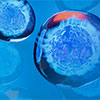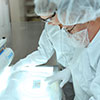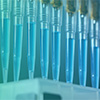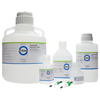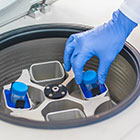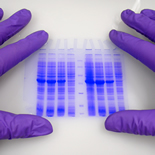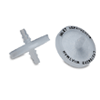Protein Purification Methods: A Comprehensive OverviewFeatured SuppliersSample preparationProtein ElectrophoresisPurificationConcentrationFeatured Products
J.T.Baker® BAKERBOND® PROchievAThe J.T.Baker® BAKERBOND® PROchievA™ recombinant protein A resin offers superior dynamic binding capacity with excellent alkaline stability linked to Avantor's proprietary ligand. 
Pall AcroPrep™ 24-Well Filter PlatesComprehensive range of higher sample volume filter plates ranging from ultrafiltration through particle filtration. 1 - 100K, 0.1 - 5μm & 30/40μm pore sizes What is protein purification?
Downstream processing in protein purificationDownstream protein purification is the final stage in bio-therapeutic manufacturing. It’s the point when the target protein is harvested and purified To explain further, downstream processing is the series of operations required to take biological materials such as cells, tissue culture fluid, or plant tissues, and derive from them a pure and homogeneous protein product. Because the product is initially trapped in a biological matrix with a vast and diverse array of non-target molecules, DSP is a multi-step process that incrementally increases the purity of the target by exploiting the physical and chemical properties that make it distinct from contaminants. DSP involves harvesting and clarification steps to remove bulk contaminants such as particulates, carbohydrates, and oils followed by capturing and polishing steps that refine the feed stream -- until only the target product remains. Trust Avantor’s experts to help you reduce downstream turnaround times in the biopharma monoclonal antibody (mAb) production process. Contact us for protein purification guidance by using this simple form.
4 Protein purification methodsProtein purification can be viewed as a combination of steps where the protein progresses in purity with each step. To purify a protein, one must begin with the starting material and fractionate it using any one of a large number of physical or biochemical approaches . The initial material can be separated into fractions using accepted approaches like those discussed below Upon extraction from the source, Centrifugation is done to isolate the proteins. Lastly, fine-resolution techniques such as chromatography provide the final product. Method # 1. Extraction:
The method of choice depends on how fragile the protein is and how sturdy the cells are. Method # 2. Precipitation and differential solubilization: One advantage of this method is that it can be performed inexpensively with very large volumes. Method # 3. Ultracentrifugation: The net effect of “spinning” the sample is that massive, small, and dense particles move outward faster than less massive particles or particles with more “drag” in the liquid. Method # 4. Chromatographic methods: Protein extraction in protein purificationThe process of protein extraction starts with very crude samples that are cleaned up through filtration, centrifugation, solubilization and precipitation, and refined with techniques such as affinity columns and immunoprecipitation. Here is a generally accepted workflow:
Precipitation and differential solubilizationDifferential protein precipitation is a rapid and economical step in protein purification and is based on exploiting the inherent physicochemical properties of the polypeptide. Precipitation of recombinant proteins, lysed from the host cell, are commonly used to concentrate the protein of choice before further polishing steps. UltracentrifugationThis process uses centrifugal force to separate mixtures of particles of varying masses or densities suspended in a liquid. When a vessel (typically a tube or bottle) containing a mixture of proteins or other particulate matter, such as bacterial cells, is rotated at high speeds, the angular momentum yields an outward force to each particle that is proportional to its mass. The tendency of a given particle to move through the liquid because of this force is offset by the resistance the liquid exerts on the particle. The net effect of “spinning” the sample in a centrifuge is that massive, small, and dense particles move outward faster than less massive particles or particles with more “drag” in the liquid. Chromatographic methodsCurrently, there are a broad range of next-generation sorbents and membranes available for chromatography. These new chromatography media are characterized by significantly improved performance compared to their classical predecessors such as:
Nevertheless, traditional media (based on agarose or polymers) continue to be routinely used due to their proven suitability for protein purification in FDA- or EMA-approved applications. Practical experience shows that the optimization of individual process steps (capture, purification, and polishing) offers important cost reductions. But it is mainly through a combination of all sorbent- and membrane-based unit operations deployed in downstream processing that the door is opened for effective process cost savings. 6 Chromatographic methods in protein purificationAt present, there are a number of chromatographic methods that can be utilized in purifying protein samples, some of which include:
Affinity tags for protein purificationWhat is Tagged protein purification?
Pull-down methods for protein complexes
Definition
Purpose
This technique can be used to verify a predicted protein interaction via Western blot or identify novel protein interactions using a total protein stain. Pull down assays can be used to identify novel protein interactions or assess how proteins bind under different conditions for any number of diseases -- or simply provide information that can offer a better picture of what’s happening in the inner world of cells.
1. Affinity pull-down assay
Definition
Pull-down assays are important tools for mapping protein-protein interaction networks. They have been successfully used on a global scale to map protein-protein interactions in a number of organisms (e.g., yeast, E. coli, C. elegans).
Process
Affinity pull-down assays are well established for the isolation and subsequent identification of protein complexes. GST pull-down assays involve affinity purifications of one or several unknown proteins from a biological sample using a GST-tagged bait protein. The basic principle is that the GST-tagged bait protein binds to its partners, and the resulting complex is captured on beads with immobilized glutathione. A control is included to identify false positives that bind to GST in the absence of a bait protein. The control can either be lysate from separately transformed cells that express GST (not the bait fusion protein) or lysate from non-transformed cells to which GST is added.
2. Tandem affinity purification
Definition
TAP employs two successive affinity chromatography steps to isolate protein complexes. The rationale behind the use of two affinity steps is to enhance the specificity of the purification procedure and hence reduce the number of false positives. Furthermore, the conditions used throughout this method are mild -- in order to preserve complex integrity and to maximize yield. The method has been used successfully in many cases.
Process
The double-tagged bait protein is expressed at near natural levels, since overexpression may trigger non-physiological interactions. The complex is first adsorbed to IgG Sepharose beads, via the protein A tag, and eluted by cleavage with TEV.
3.Identifying Protein Interactions via Co-immunoprecipitation
Definition
The name is historical and originates from analysis methods based on the precipitation reaction obtained when mixing antibody and antigen at the correct ratio.
Overview
Downstream optimization in protein purificationThe ultimate goal in the downstream optimization of recombinant proteins and other biologics is to improve recovery and reduce the cost per gram of protein produced. This requires producing more drug product, in less time, and with the same amount of resin and buffer material. Biomanufacturers can achieve this by making better use of the newest generation of mixed-mode and multimode resins and more efficient buffer management practices. Avantor’s services teams can work closely with you to identify biopharma scale-up bottlenecks, streamline production processes, and improve efficiency and productivity so you can shorten time to market for life-saving solutions. See our services page for more valuable information about downstream optimization. From pre-clinical through commercial manufacturing, Avantor works closely with biopharmaceutical customers to reduce downstream optimization turnaround times so biopharmaceutical customers can reach the market faster with new therapeutics. Ready to get started? Contact your Avantor account manager to take the next step. |

|
Processing your request... |



